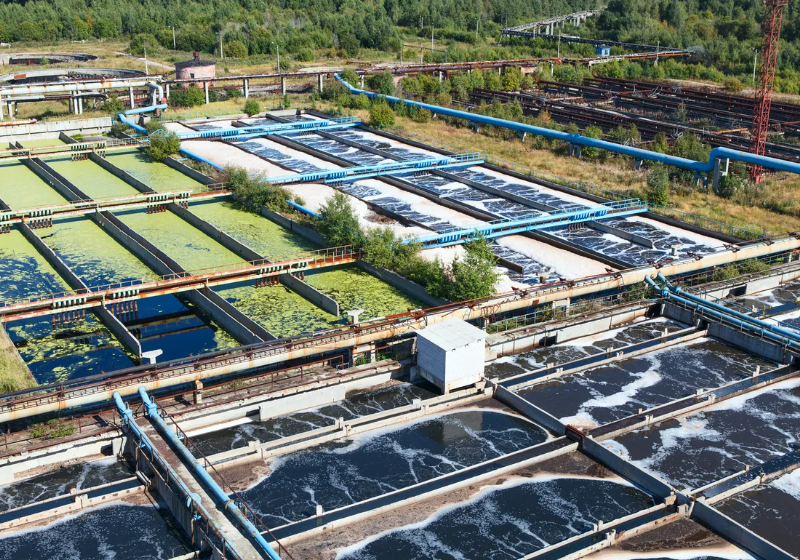Application of Anaerobic Technology
Chemical wastewater has high salt content,COD and chroma. Different industrial wastewater contains different refractory substances and toxic substances.
According to the different chemical composition, it mainly includes Organic Substances from synthetic materials, pesticides, dyes and other industries (such as phenols, organic phosphorus, organic chlorine, etc.).Inorganic Substances (mercury, chromium, lead, acid-base salt, fluoride, etc.) from industries such as inorganic salt, nitrogen fertilizer, phosphate fertilizer, sulfo nitric acid and soda ash.Mixtures from chlor alkali, photosensitive materials and coatings industries.
According to different physical states, there are mainly Insoluble Substances (such as suspended solids, colloidal substances, floating oil, etc.) and water soluble Organic and Inorganic Pollutants.
Application of Anaerobic Technology in Chemical Wastewater Treatment
Ordinary Anaerobic Digestion Tank
Anaerobic Biofilter
Upflow Anaerobic Sludge Bed Reactor
Anaerobic Baffled Reactor
Anaerobic Expanded Granular Sludge Bed Reactor
Anaerobic Sequencing Batch Reactor
Two-phase Anaerobic Digestion Biological Treatment Process
Ordinary Anaerobic Digestion Tank
Ordinary anaerobic digester is one of the earliest wastewater and sewage water treatment technologies. In the early stage, it was mainly used for the stabilization of sludge. Later, it was successfully applied in the treatment of industrial organic wastewater containing high solid concentration.
Anaerobic Biofilter
Anaerobic Biological Filtration Process (AF) is an anaerobic reactor filled with fillers and attached with microorganisms. Waste water enters the reactor from the upper (upward flow) or lower (downward flow). Through the fixed packed bed, organic matter in the waste water is anaerobic decomposed and biogas is generated.
Upflow Anaerobic Sludge Bed Reactor
Upflow Anaerobic Sludge Blanket Reactor (UASB) is a suspended growth bioreactor, which consists of three parts: reaction area, sedimentation area and air chamber. The bottom of the reactor is a sludge layer with high concentration, the upper part of the sludge layer is a sludge suspension layer with low concentration, and the top is equipped with a three-phase separator of gas, liquid and solid, so that the sludge in the reactor is not easy to lose, so the reactor can maintain a high biomass.
Anaerobic Baffled Reactor
Anaerobic Baffled Reactor (ABR) is equipped with several vertical guide flow plates to separate the reactor into several reaction chambers in series. Each reaction chamber can be regarded as a relatively independent upflow sludge bed system. The microbial phase in each reaction chamber of the ABR reactor changes step by step with the process. The rule of gradual change is consistent with the substrate degradation process, so as to ensure that the corresponding microbial phase has the best working activity.
Anaerobic Expanded Granular Sludge Bed Reactor
The expanded granular sludge bed reactor (EGSB) is an improvement of the UASB reactor. It can achieve high treatment efficiency for low temperature and low concentration organic wastewater under high load, and maintain a high flow rate.
The granular sludge bed in the reactor is in an expanded state. The expanded bed improves the contact between organics and microorganisms in wastewater. The granular sludge has good performance, strengthens the mass transfer effect, improves the biochemical reaction speed of the reactor, and greatly improves the treatment efficiency of the reactor.
Anaerobic Sequencing Batch Reactor
In the 1990s, American scholars such as DAGUE applied SBR process of aerobic biological treatment to anaerobic biological treatment and developed anaerobic sequencing batch reactor (ASBR). The ASBR process is still in the experimental stage at present, and its special intermittent operation mode can theoretically obtain more efficient biological flocculation (even granulation) and solid-liquid separation effects than the ordinary anaerobic activated sludge process with continuous influent.
Two-phase Anaerobic Digestion Biological Treatment Process
It is also called two-step or two-stage anaerobic digestion. The essence of two-phase anaerobic biological treatment process is to make the acidogenic phase and methanogenic phase become two independent treatment units by regulating the operation control parameters of the acidogenic phase and methanogenic phase reactors, forming the optimal ecological conditions for the acidogenic and methanogenic fermentation microorganisms respectively, so as to achieve a complete anaerobic fermentation process.
There are mainly two types of process used in two-phase anaerobic system research: the first is that both phases use the same type of reactor, such as UASB reactor, UBF reactor and ASBR reactor, among which UASB reactor is more commonly used. The second process is called Anodek, which is characterized by that the acidogenic phase is a contact reactor (i.e., a sedimentation tank is set behind the complete reactor, and sludge reflux is carried out at the same time), and the methanogenic phase uses other types of reactors.
Anaerobic technology has incomparable advantages over traditional aerobic technology in terms of economy and specific high concentration organic wastewater, but at the same time, there are many shortcomings in treating a specific chemical wastewater. The temperature, concentration, alkalinity and effluent quality requirements of wastewater limit the application of anaerobic treatment technology.
#QDEVU #WATERTREATMENT #WASTEWATERTREATMENT #SEWAGEWATERTREATMENT #BIOLOGICALTREATMENT



